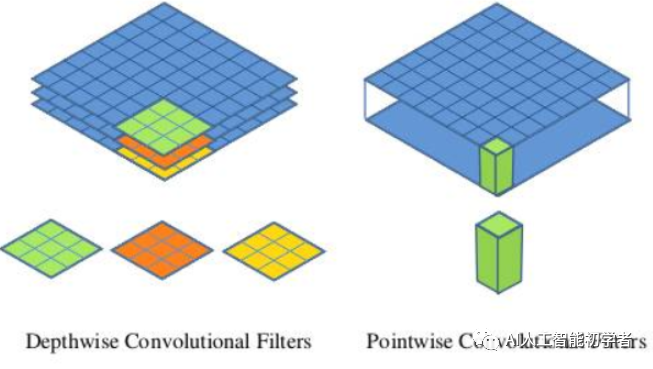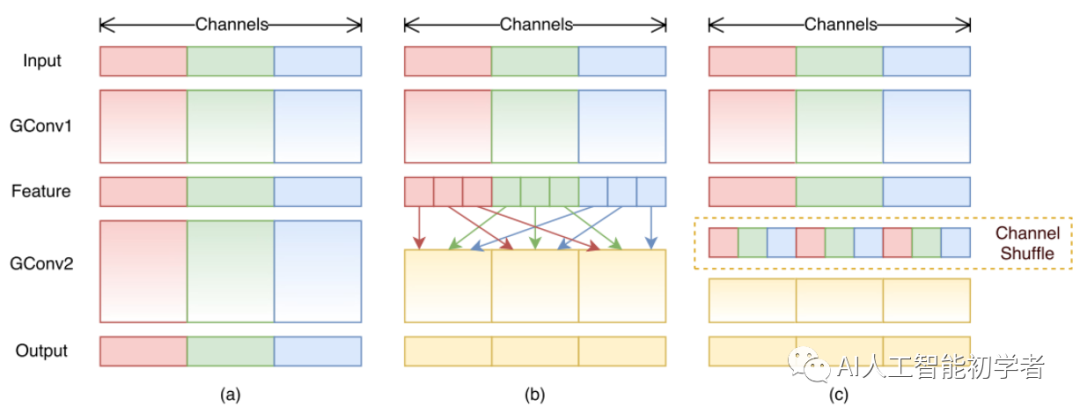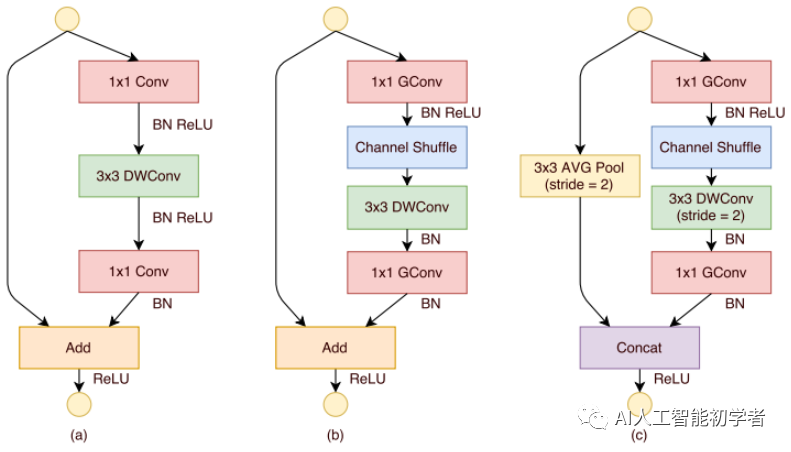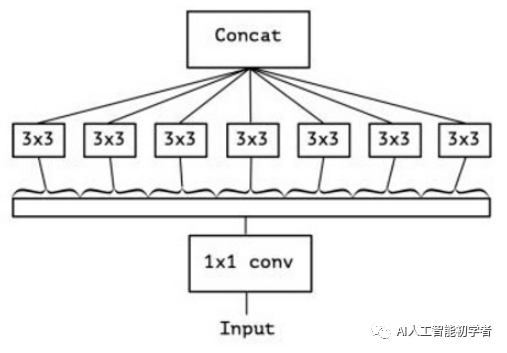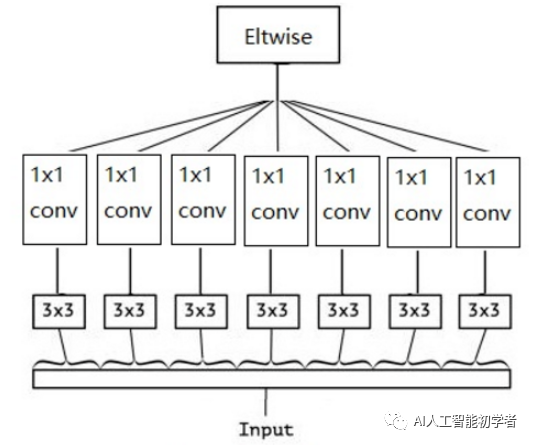转载自:AI人工智能初学者
作者:ChaucerG
1 轻量化网络简介
前面所提网络在向着越来越大、越来越深的方向发展,但在实际应用中计算性能有限,但又有着极强的业务需求。对于效率问题,可以想到的方法通常是对模型进行压缩与剪枝,降低网络的参数量,从而降低计算量加快推理速度。相较于对模型进行后处理的方法,轻量化模型设计则是另辟蹊径。
轻量化模型主要是设计更加高效的网络计算方式,在降低网络参数的同时,不损失性能。
常用的四个轻量化模型系列:_SqueezeNet、MobileNet、ShuffleNet、Xception_。这些模型在实际场景中都得到了广泛的应用。
1.1 SqueezeNet
SqueezeNet是一个人工设计的轻量化网络,它在ImageNet上实现了和AlexNet相同水平的正确率,但是只使用了1/50的参数。更进一步,使用模型压缩技术,可以将SqueezeNet压缩到0.5MB,这是AlexNet的1/510。
引入了两个术语CNN微结构和CNN宏结构。
- CNN微结构:由层或几个卷积层组成的小模块,如inception模块。
- CNN宏结构:由层或模块组成的完整的网络结构,此时深度是一个重要的参数。
网络结构的设计策略:
- (1)代替3x3的滤波器为1x1,这样会减少9倍的参数。
- (2)减少输入到3x3滤波器的输入通道,这样可以进一步减少参数,本文使用squeeze层来实现。
- (3)降采样操作延后,可以给卷积层更大的激活特征图,意味着保留的信息更多,可以提升准确率。
策略是减少参数的方案,是在限制参数预算的情况下最大化准确率。如下图所示作者引入了Fire模块来构造CNN,此模块成功地应用了上述的3个策略。
模块由squeeze层和expand层组成,squeeze层由1x1的卷积层组成,,可以减少输入expand层的特征图的输入通道。expand层由1x1和3x3的卷积混合而成,<,称为扩展了特征图。
PyTorch实现Fire模块如下:
class Fire(nn.Module):
def __init__(self, inplanes, squeeze_planes, expand1x1_planes, expand3x3_planes):
super(Fire, self).__init__()
self.inplanes = inplanes
self.squeeze = nn.Conv2d(inplanes, squeeze_planes, kernel_size=1)
self.squeeze_activation = nn.ReLU(inplace=True)
self.expand1x1 = nn.Conv2d(squeeze_planes, expand1x1_planes, kernel_size=1)
self.expand1x1_activation = nn.ReLU(inplace=True)
self.expand3x3 = nn.Conv2d(squeeze_planes, expand3x3_planes, kernel_size=3, padding=1)
self.expand3x3_activation = nn.ReLU(inplace=True)
def forward(self, x):
x = self.squeeze_activation(self.squeeze(x))
return torch.cat([
self.expand1x1_activation(self.expand1x1(x)),
self.expand3x3_activation(self.expand3x3(x))
], 1) 整体结构以普通的卷积层(conv1)开始,接着连接8个Fire(2-9)模块,最后以卷积层(conv10)结束。每个Fire模块的filter数量逐渐增加,并且在conv1,Fire4,Fire8和conv10后使用步长为2的max-pooling,这种相对延迟的pooling符合了策略(3)。如下作者对比了添加跳跃层的squeezenet:
class SqueezeNet(nn.Module):
def __init__(self, version=1.0, num_classes=1000):
super(SqueezeNet, self).__init__()
if version not in [1.0, 1.1]:
raise ValueError("Unsupported SqueezeNet version {version}: 1.0 or 1.1 expected".format(version=version))
self.num_classes = num_classes
if version == 1.0:
self.features = nn.Sequential(
nn.Conv2d(3, 96, kernel_size=7, stride=2),
nn.ReLU(inplace=True),
nn.MaxPool2d(kernel_size=3, stride=2, ceil_mode=True),
Fire(96, 16, 64, 64),
Fire(128, 16, 64, 64),
Fire(128, 32, 128, 128),
nn.MaxPool2d(kernel_size=3, stride=2, ceil_mode=True),
Fire(256, 32, 128, 128),
Fire(256, 48, 192, 192),
Fire(384, 48, 192, 192),
Fire(384, 64, 256, 256),
nn.MaxPool2d(kernel_size=3, stride=2, ceil_mode=True),
Fire(512, 64, 256, 256),
)
else:
self.features = nn.Sequential(
nn.Conv2d(3, 64, kernel_size=3, stride=2),
nn.ReLU(inplace=True),
nn.MaxPool2d(kernel_size=3, stride=2, ceil_mode=True),
Fire(64, 16, 64, 64),
Fire(128, 16, 64, 64),
nn.MaxPool2d(kernel_size=3, stride=2, ceil_mode=True),
Fire(128, 32, 128, 128),
Fire(256, 32, 128, 128),
nn.MaxPool2d(kernel_size=3, stride=2, ceil_mode=True),
Fire(256, 48, 192, 192),
Fire(384, 48, 192, 192),
Fire(384, 64, 256, 256),
Fire(512, 64, 256, 256),
)
# Final convolution is initialized differently form the rest
final_conv = nn.Conv2d(512, self.num_classes, kernel_size=1)
self.classifier = nn.Sequential(
nn.Dropout(p=0.5), final_conv, nn.ReLU(inplace=True),
nn.AdaptiveAvgPool2d((1, 1))
)
for m in self.modules():
if isinstance(m, nn.Conv2d):
if m is final_conv:
init.normal_(m.weight, mean=0.0, std=0.01)
else:
init.kaiming_uniform_(m.weight)
if m.bias is not None:
init.constant_(m.bias, 0)
def forward(self, x):
x = self.features(x)
x = self.classifier(x)
return x.view(x.size(0), self.num_classes) 1.2 MobileNet
mobilenet做的一个工作相当于把卷积核拆分,并提出了逐点卷积depthwise separable convolutions。如下图:
简单解释一下depthwise separable convolutions:假设输入的feature map有C1层,先对每一层先进行3x3的卷积,得到新的C1层的feature map,对新的feature map进行1x1卷积,得到输出的C2层feature map。所以整个过程参数为:3x3xC1+1x1xC1xC2。
class MobileNet(nn.Module):
def __init__(self):
super(MobileNet, self).__init__()
def conv_bn(inp, oup, stride):
return nn.Sequential(
nn.Conv2d(inp, oup, 3, stride, 1, bias=False),
nn.BatchNorm2d(oup),
nn.ReLU(inplace=True)
)
def conv_dw(inp, oup, stride):
return nn.Sequential(
nn.Conv2d(inp, inp, 3, stride, 1, groups=inp, bias=False),
nn.BatchNorm2d(inp),
nn.ReLU(inplace=True),
nn.Conv2d(inp, oup, 1, 1, 0, bias=False),
nn.BatchNorm2d(oup),
nn.ReLU(inplace=True),
)
self.model = nn.Sequential(
conv_bn( 3, 32, 2),
conv_dw( 32, 64, 1),
conv_dw( 64, 128, 2),
conv_dw(128, 128, 1),
conv_dw(128, 256, 2),
conv_dw(256, 256, 1),
conv_dw(256, 512, 2),
conv_dw(512, 512, 1),
conv_dw(512, 512, 1),
conv_dw(512, 512, 1),
conv_dw(512, 512, 1),
conv_dw(512, 512, 1),
conv_dw(512, 1024, 2),
conv_dw(1024, 1024, 1),
nn.AvgPool2d(7), )
self.fc = nn.Linear(1024, 1000)
def forward(self, x):
x = self.model(x)
x = x.view(-1, 1024)
x = self.fc(x)
return x 后续的Mobilenet v2针对Mobilenet v1,作者进一步提出了改进方案,作者发现在通道数少的情况下不应该接relu这个激活函数,会造成大量节点变0的情况,因此作者提出了类似于resnet的残差概念,将前面还没有置零的部分直接加和到下一层。除此之外,在通道数较少的层仅仅采用线性函数,而取消了非线性的relu激活。
1.3 ShuffleNet
ShuffleNet是由2017年07月发布的轻量级网络,设计用于移动端设备,在MobileNet之后的网络架构。主要的创新点在于使用了分组卷积(group convolution)和通道打乱(channel shuffle)。
分组卷积(group convolution)
分组卷积最早由AlexNet中使用。由于当时的硬件资源有限,训练AlexNet时卷积操作不能全部放在同一个GPU处理,因此作者把特征图分给多个GPU分别进行处理,最后把特征图结果进行连接。
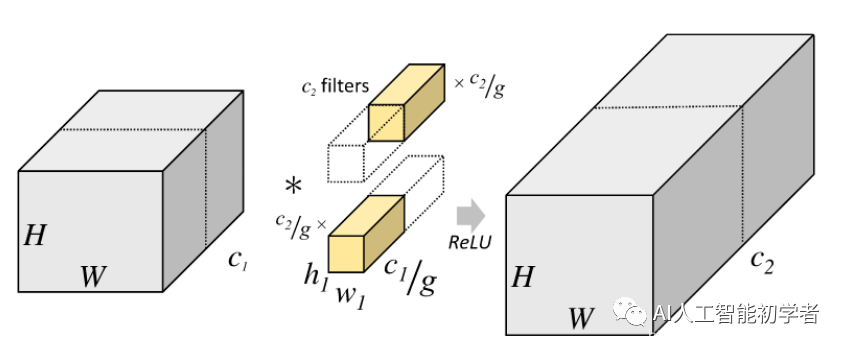
通道打乱(channel shuffle)
通道打乱并不是随机打乱,而是有规律地打乱。
- :表示的是使用分组卷积处理未加打乱的特征图。每一个输出通道都对应组内的输入通道。
- :对组卷积GConv1处理后的特征图channel进行如上方式的打乱,此时大部分输出通道会对应不同组的输入通道;
- 是与的等价实现,将通道调整到合适的位置。
ShuffleNet单元
- :是ResNet提出的bottleneck层,只是将3x3的卷积替换为depthwise(DW)卷积。
- :是1x1卷积变为pointwise分组卷积(GConv),并且加入了通道打乱。按照DW卷积的原论文,在3x3的DW后面不添加非线性因素。最后的点卷积用来匹配相加操作。
- :加入了stride=2去减少特征图尺寸,旁路加入平均池化层来维持相同的尺寸,最终在channel水平上连接特征图。
以下是基于PyTorch实现的ShuffleNet:
import torch
import torch.nn as nn
import torch.nn.functional as F
class ShuffleBlock(nn.Module):
def __init__(self, groups):
super(ShuffleBlock, self).__init__()
self.groups = groups
def forward(self, x):
'''Channel shuffle: [N,C,H,W] -> [N,g,C/g,H,W] -> [N,C/g,g,H,w] -> [N,C,H,W]'''
N,C,H,W = x.size()
g = self.groups
# 维度变换之后必须要使用.contiguous()使得张量在内存连续之后才能调用view函数
return x.view(N,g,int(C/g),H,W).permute(0,2,1,3,4).contiguous().view(N,C,H,W)
class Bottleneck(nn.Module):
def __init__(self, in_planes, out_planes, stride, groups):
super(Bottleneck, self).__init__()
self.stride = stride
# bottleneck层中间层的channel数变为输出channel数的1/4
mid_planes = int(out_planes/4)
g = 1 if in_planes==24 else groups
# 作者提到不在stage2的第一个pointwise层使用组卷积,因为输入channel数量太少,只有24
self.conv1 = nn.Conv2d(in_planes, mid_planes, kernel_size=1, groups=g, bias=False)
self.bn1 = nn.BatchNorm2d(mid_planes)
self.shuffle1 = ShuffleBlock(groups=g)
self.conv2 = nn.Conv2d(mid_planes, mid_planes, kernel_size=3, stride=stride, padding=1, groups=mid_planes, bias=False)
self.bn2 = nn.BatchNorm2d(mid_planes)
self.conv3 = nn.Conv2d(mid_planes, out_planes, kernel_size=1, groups=groups, bias=False)
self.bn3 = nn.BatchNorm2d(out_planes)
self.shortcut = nn.Sequential()
if stride == 2:
self.shortcut = nn.Sequential(nn.AvgPool2d(3, stride=2, padding=1))
def forward(self, x):
out = F.relu(self.bn1(self.conv1(x)))
out = self.shuffle1(out)
out = F.relu(self.bn2(self.conv2(out)))
out = self.bn3(self.conv3(out))
res = self.shortcut(x)
out = F.relu(torch.cat([out,res], 1)) if self.stride==2 else F.relu(out+res)
return out
class ShuffleNet(nn.Module):
def __init__(self, cfg):
super(ShuffleNet, self).__init__()
out_planes = cfg['out_planes']
num_blocks = cfg['num_blocks']
groups = cfg['groups']
self.conv1 = nn.Conv2d(3, 24, kernel_size=1, bias=False)
self.bn1 = nn.BatchNorm2d(24)
self.in_planes = 24
self.layer1 = self._make_layer(out_planes[0], num_blocks[0], groups)
self.layer2 = self._make_layer(out_planes[1], num_blocks[1], groups)
self.layer3 = self._make_layer(out_planes[2], num_blocks[2], groups)
self.linear = nn.Linear(out_planes[2], 10)
def _make_layer(self, out_planes, num_blocks, groups):
layers = []
for i in range(num_blocks):
if i == 0:
layers.append(Bottleneck(self.in_planes, out_planes-self.in_planes, stride=2, groups=groups))
else:
layers.append(Bottleneck(self.in_planes, out_planes, stride=1, groups=groups))
self.in_planes = out_planes
return nn.Sequential(*layers)
def forward(self, x):
out = F.relu(self.bn1(self.conv1(x)))
out = self.layer1(out)
out = self.layer2(out)
out = self.layer3(out)
out = F.avg_pool2d(out, 4)
out = out.view(out.size(0), -1)
out = self.linear(out)
return out
def ShuffleNetG2():
cfg = {
'out_planes': [200,400,800],
'num_blocks': [4,8,4],
'groups': 2
}
return ShuffleNet(cfg)
def ShuffleNetG3():
cfg = {
'out_planes': [240,480,960],
'num_blocks': [4,8,4],
'groups': 3
}
return ShuffleNet(cfg)
def test():
net = ShuffleNetG2()
x = torch.randn(1,3,32,32)
y = net(x)
print(y)
test() 1.4 Xception
Xception并不是真正意义上的轻量化模型,借鉴depth-wise convolution,而depth-wise convolution又是上述几个轻量化模型的关键点,其思想非常值得借鉴。
Xception是基于Inception-V3,并结合了depth-wise convolution,这样做的好处是提高网络效率,以及在同等参数量的情况下,在大规模数据集上,效果要优于Inception-V3。这也提供了另外一种“轻量化”的思路:在硬件资源给定的情况下,尽可能的增加网络效率和性能,也可以理解为充分利用硬件资源。
以下为基于PyTorch实现的Xception代码:
import math
import torch
import torch.nn as nn
import torch.nn.functional as F
import torch.utils.model_zoo as model_zoo
from modeling.sync_batchnorm.batchnorm import SynchronizedBatchNorm2d
def fixed_padding(inputs, kernel_size, dilation):
kernel_size_effective = kernel_size + (kernel_size - 1) * (dilation - 1)
pad_total = kernel_size_effective - 1
pad_beg = pad_total // 2
pad_end = pad_total - pad_beg
padded_inputs = F.pad(inputs, (pad_beg, pad_end, pad_beg, pad_end))
return padded_inputs
class SeparableConv2d(nn.Module):
def __init__(self, inplanes, planes, kernel_size=3, stride=1, dilation=1, bias=False, BatchNorm=None):
super(SeparableConv2d, self).__init__()
self.conv1 = nn.Conv2d(inplanes, inplanes, kernel_size, stride, 0, dilation, groups=inplanes, bias=bias)
self.bn = BatchNorm(inplanes)
self.pointwise = nn.Conv2d(inplanes, planes, 1, 1, 0, 1, 1, bias=bias)
def forward(self, x):
x = fixed_padding(x, self.conv1.kernel_size[0], dilation=self.conv1.dilation[0])
x = self.conv1(x)
x = self.bn(x)
x = self.pointwise(x)
return x
class Block(nn.Module):
def __init__(self, inplanes, planes, reps, stride=1, dilation=1, BatchNorm=None,
start_with_relu=True, grow_first=True, is_last=False):
super(Block, self).__init__()
if planes != inplanes or stride != 1:
self.skip = nn.Conv2d(inplanes, planes, 1, stride=stride, bias=False)
self.skipbn = BatchNorm(planes)
else:
self.skip = None
self.relu = nn.ReLU(inplace=True)
rep = []
filters = inplanes
if grow_first:
rep.append(self.relu)
rep.append(SeparableConv2d(inplanes, planes, 3, 1, dilation, BatchNorm=BatchNorm))
rep.append(BatchNorm(planes))
filters = planes
for i in range(reps - 1):
rep.append(self.relu)
rep.append(SeparableConv2d(filters, filters, 3, 1, dilation, BatchNorm=BatchNorm))
rep.append(BatchNorm(filters))
if not grow_first:
rep.append(self.relu)
rep.append(SeparableConv2d(inplanes, planes, 3, 1, dilation, BatchNorm=BatchNorm))
rep.append(BatchNorm(planes))
if stride != 1:
rep.append(self.relu)
rep.append(SeparableConv2d(planes, planes, 3, 2, BatchNorm=BatchNorm))
rep.append(BatchNorm(planes))
if stride == 1 and is_last:
rep.append(self.relu)
rep.append(SeparableConv2d(planes, planes, 3, 1, BatchNorm=BatchNorm))
rep.append(BatchNorm(planes))
if not start_with_relu:
rep = rep[1:]
self.rep = nn.Sequential(*rep)
def forward(self, inp):
x = self.rep(inp)
if self.skip is not None:
skip = self.skip(inp)
skip = self.skipbn(skip)
else:
skip = inp
x = x + skip
return x
class AlignedXception(nn.Module):
def __init__(self, output_stride, BatchNorm,
pretrained=True):
super(AlignedXception, self).__init__()
if output_stride == 16:
entry_block3_stride = 2
middle_block_dilation = 1
exit_block_dilations = (1, 2)
elif output_stride == 8:
entry_block3_stride = 1
middle_block_dilation = 2
exit_block_dilations = (2, 4)
else:
raise NotImplementedError
# Entry flow
self.conv1 = nn.Conv2d(3, 32, 3, stride=2, padding=1, bias=False)
self.bn1 = BatchNorm(32)
self.relu = nn.ReLU(inplace=True)
self.conv2 = nn.Conv2d(32, 64, 3, stride=1, padding=1, bias=False)
self.bn2 = BatchNorm(64)
self.block1 = Block(64, 128, reps=2, stride=2, BatchNorm=BatchNorm, start_with_relu=False)
self.block2 = Block(128, 256, reps=2, stride=2, BatchNorm=BatchNorm, start_with_relu=False, grow_first=True)
self.block3 = Block(256, 728, reps=2, stride=entry_block3_stride, BatchNorm=BatchNorm, start_with_relu=True, grow_first=True, is_last=True)
# Middle flow
self.block4 = Block(728, 728, reps=3, stride=1, dilation=middle_block_dilation,
BatchNorm=BatchNorm, start_with_relu=True, grow_first=True)
self.block5 = Block(728, 728, reps=3, stride=1, dilation=middle_block_dilation,
BatchNorm=BatchNorm, start_with_relu=True, grow_first=True)
self.block6 = Block(728, 728, reps=3, stride=1, dilation=middle_block_dilation,
BatchNorm=BatchNorm, start_with_relu=True, grow_first=True)
self.block7 = Block(728, 728, reps=3, stride=1, dilation=middle_block_dilation,
BatchNorm=BatchNorm, start_with_relu=True, grow_first=True)
self.block8 = Block(728, 728, reps=3, stride=1, dilation=middle_block_dilation,
BatchNorm=BatchNorm, start_with_relu=True, grow_first=True)
self.block9 = Block(728, 728, reps=3, stride=1, dilation=middle_block_dilation,
BatchNorm=BatchNorm, start_with_relu=True, grow_first=True)
self.block10 = Block(728, 728, reps=3, stride=1, dilation=middle_block_dilation,
BatchNorm=BatchNorm, start_with_relu=True, grow_first=True)
self.block11 = Block(728, 728, reps=3, stride=1, dilation=middle_block_dilation,
BatchNorm=BatchNorm, start_with_relu=True, grow_first=True)
self.block12 = Block(728, 728, reps=3, stride=1, dilation=middle_block_dilation,
BatchNorm=BatchNorm, start_with_relu=True, grow_first=True)
self.block13 = Block(728, 728, reps=3, stride=1, dilation=middle_block_dilation,
BatchNorm=BatchNorm, start_with_relu=True, grow_first=True)
self.block14 = Block(728, 728, reps=3, stride=1, dilation=middle_block_dilation,
BatchNorm=BatchNorm, start_with_relu=True, grow_first=True)
self.block15 = Block(728, 728, reps=3, stride=1, dilation=middle_block_dilation,
BatchNorm=BatchNorm, start_with_relu=True, grow_first=True)
self.block16 = Block(728, 728, reps=3, stride=1, dilation=middle_block_dilation,
BatchNorm=BatchNorm, start_with_relu=True, grow_first=True)
self.block17 = Block(728, 728, reps=3, stride=1, dilation=middle_block_dilation,
BatchNorm=BatchNorm, start_with_relu=True, grow_first=True)
self.block18 = Block(728, 728, reps=3, stride=1, dilation=middle_block_dilation,
BatchNorm=BatchNorm, start_with_relu=True, grow_first=True)
self.block19 = Block(728, 728, reps=3, stride=1, dilation=middle_block_dilation,
BatchNorm=BatchNorm, start_with_relu=True, grow_first=True)
# Exit flow
self.block20 = Block(728, 1024, reps=2, stride=1, dilation=exit_block_dilations[0], BatchNorm=BatchNorm, start_with_relu=True, grow_first=False, is_last=True)
self.conv3 = SeparableConv2d(1024, 1536, 3, stride=1, dilation=exit_block_dilations[1], BatchNorm=BatchNorm)
self.bn3 = BatchNorm(1536)
self.conv4 = SeparableConv2d(1536, 1536, 3, stride=1, dilation=exit_block_dilations[1], BatchNorm=BatchNorm)
self.bn4 = BatchNorm(1536)
self.conv5 = SeparableConv2d(1536, 2048, 3, stride=1, dilation=exit_block_dilations[1], BatchNorm=BatchNorm)
self.bn5 = BatchNorm(2048)
# Init weights
self._init_weight()
# Load pretrained model
if pretrained:
self._load_pretrained_model()
def forward(self, x):
# Entry flow
x = self.conv1(x)
x = self.bn1(x)
x = self.relu(x)
x = self.conv2(x)
x = self.bn2(x)
x = self.relu(x)
x = self.block1(x)
# add relu here
x = self.relu(x)
low_level_feat = x
x = self.block2(x)
x = self.block3(x)
# Middle flow
x = self.block4(x)
x = self.block5(x)
x = self.block6(x)
x = self.block7(x)
x = self.block8(x)
x = self.block9(x)
x = self.block10(x)
x = self.block11(x)
x = self.block12(x)
x = self.block13(x)
x = self.block14(x)
x = self.block15(x)
x = self.block16(x)
x = self.block17(x)
x = self.block18(x)
x = self.block19(x)
# Exit flow
x = self.block20(x)
x = self.relu(x)
x = self.conv3(x)
x = self.bn3(x)
x = self.relu(x)
x = self.conv4(x)
x = self.bn4(x)
x = self.relu(x)
x = self.conv5(x)
x = self.bn5(x)
x = self.relu(x)
return x, low_level_feat
def _init_weight(self):
for m in self.modules():
if isinstance(m, nn.Conv2d):
n = m.kernel_size[0] * m.kernel_size[1] * m.out_channels
m.weight.data.normal_(0, math.sqrt(2. / n))
elif isinstance(m, SynchronizedBatchNorm2d):
m.weight.data.fill_(1)
m.bias.data.zero_()
elif isinstance(m, nn.BatchNorm2d):
m.weight.data.fill_(1)
m.bias.data.zero_()
def _load_pretrained_model(self):
pretrain_dict = model_zoo.load_url('http://data.lip6.fr/cadene/pretrainedmodels/xception-b5690688.pth')
model_dict = {}
state_dict = self.state_dict()
for k, v in pretrain_dict.items():
if k in state_dict:
if 'pointwise' in k:
v = v.unsqueeze(-1).unsqueeze(-1)
if k.startswith('block11'):
model_dict[k] = v
model_dict[k.replace('block11', 'block12')] = v
model_dict[k.replace('block11', 'block13')] = v
model_dict[k.replace('block11', 'block14')] = v
model_dict[k.replace('block11', 'block15')] = v
model_dict[k.replace('block11', 'block16')] = v
model_dict[k.replace('block11', 'block17')] = v
model_dict[k.replace('block11', 'block18')] = v
model_dict[k.replace('block11', 'block19')] = v
elif k.startswith('block12'):
model_dict[k.replace('block12', 'block20')] = v
elif k.startswith('bn3'):
model_dict[k] = v
model_dict[k.replace('bn3', 'bn4')] = v
elif k.startswith('conv4'):
model_dict[k.replace('conv4', 'conv5')] = v
elif k.startswith('bn4'):
model_dict[k.replace('bn4', 'bn5')] = v
else:
model_dict[k] = v
state_dict.update(model_dict)
self.load_state_dict(state_dict)
if __name__ == "__main__":
import torch
model = AlignedXception(BatchNorm=nn.BatchNorm2d, pretrained=True, output_stride=16)
input = torch.rand(1, 3, 512, 512)
output, low_level_feat = model(input)
print(output.size())
print(low_level_feat.size()) 轻量化模型小结
轻量化主要得益于depth-wise convolution,因此大家可以考虑采用depth-wise convolution来设计自己的轻量化网络,但是要注意信息流通不畅问题。
解决“信息流通不畅”的问题:
- MobileNet采用了point-wise convolution
- ShuffleNet采用的是channel shuffle
MobileNet相较于ShuffleNet使用了更多的卷积,计算量和参数量上是劣势,但是增加了非线性层数,理论上特征更抽象,更高级了;ShuffleNet则省去point-wise convolution,采用channel shuffle,简单明了,省去卷积步骤,减少了参数量。
下图是对全文以及上一篇笔记的经典卷积神经网络的总结,可以说是很全面的了!!!
推荐专栏文章
更多嵌入式AI算法部署等请关注极术嵌入式AI专栏。


